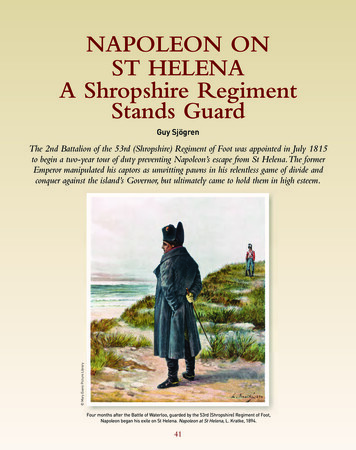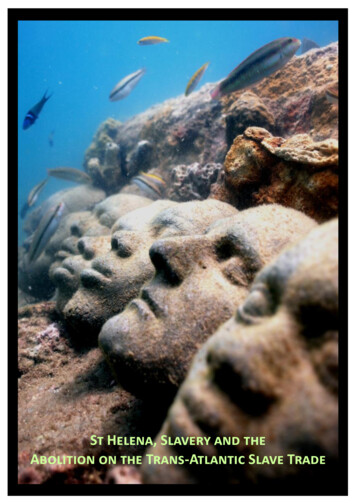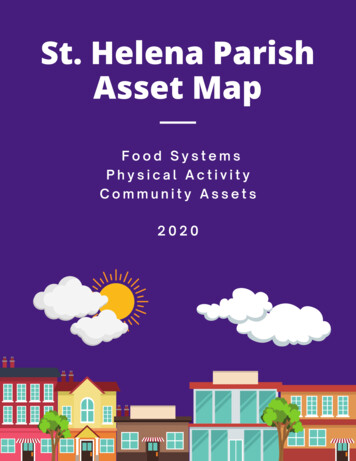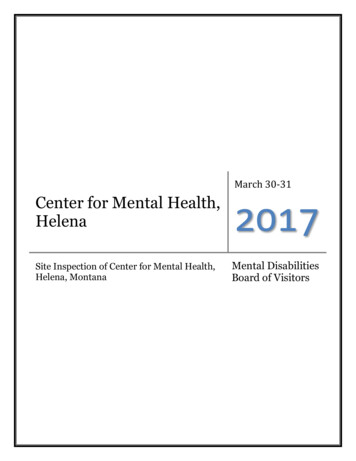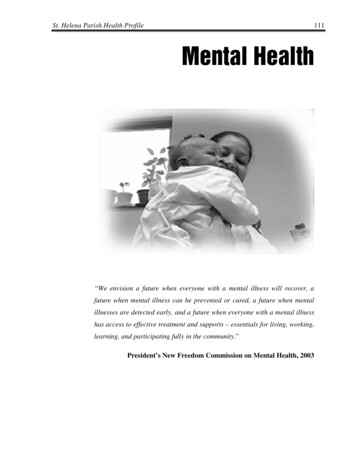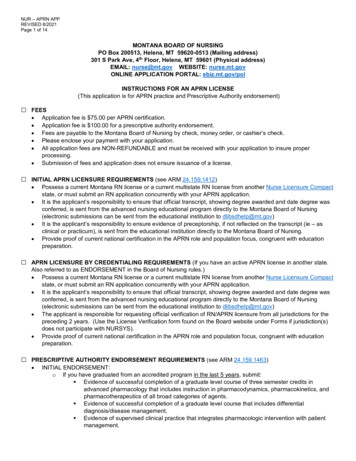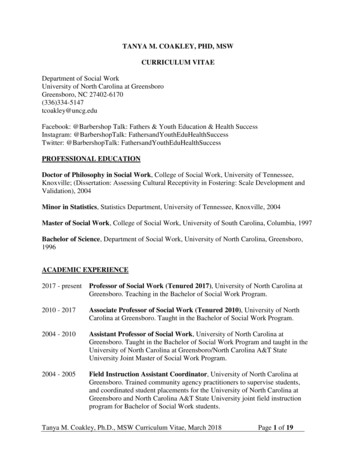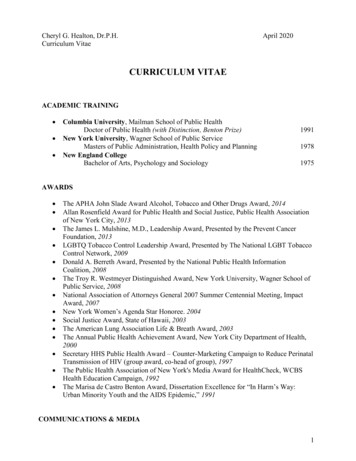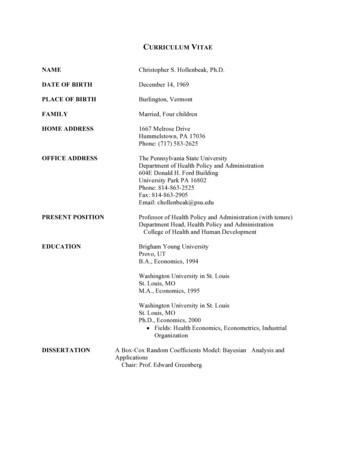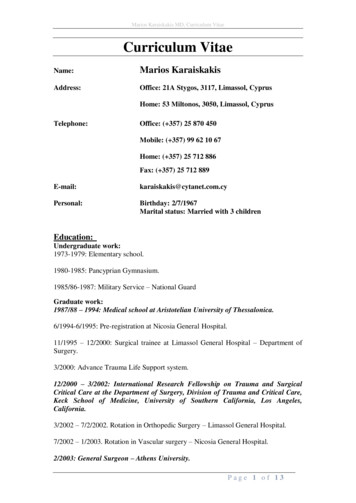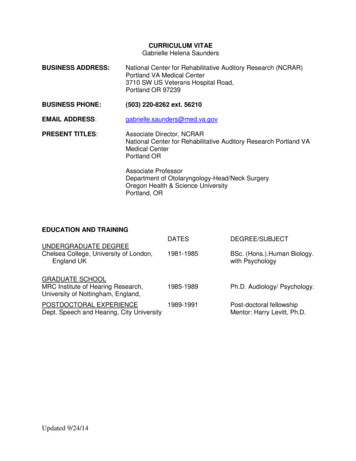
Transcription
CURRICULUM VITAEGabrielle Helena SaundersBUSINESS ADDRESS:National Center for Rehabilitative Auditory Research (NCRAR)Portland VA Medical Center3710 SW US Veterans Hospital Road,Portland OR 97239BUSINESS PHONE:(503) 220-8262 ext. 56210EMAIL ADDRESS:gabrielle.saunders@med.va.govPRESENT TITLES:Associate Director, NCRARNational Center for Rehabilitative Auditory Research Portland VAMedical CenterPortland ORAssociate ProfessorDepartment of Otolaryngology-Head/Neck SurgeryOregon Health & Science UniversityPortland, OREDUCATION AND TRAININGDATESDEGREE/SUBJECTUNDERGRADUATE DEGREEChelsea College, University of London,England UK1981-1985BSc. (Hons.).Human Biology.with PsychologyGRADUATE SCHOOLMRC Institute of Hearing Research,University of Nottingham, England,1985-1989Ph.D. Audiology/ Psychology.POSTDOCTORAL EXPERIENCE1989-1991Dept. Speech and Hearing, City UniversityUpdated 9/24/14Post-doctoral fellowshipMentor: Harry Levitt, Ph.D.
CURRENT PROFESSIONAL MEMBERSHIPSAmerican Speech-Language-Hearing AssociationAmerican Auditory SocietyAmerican Academy of AudiologyAcademy of Rehabilitative AudiologyInternational Society of AudiologyAWARDS/HONORS/ELECTED POSITIONSTechnical Chair (Elected), International Hearing Aid Conference (IHCON) 2016 2014 - 2016Invited Presenter, Institute of Medicine of the National Academy of SciencesWorkshop on Hearing Loss and Healthy Aging2014Elected Member, International Collegium for Rehabilitative Audiology (ICRA)2013 - presentInvited Member ASHA Ad Hoc Committee on Audiology Outcomes2013 - presentSpecial Appreciation Award for service to Academy Rehabilitative Audiologyand research in audiologic rehabilitation2012Invited participant, American Speech-Language-Hearing AssociationChanging Health Care Landscape Summit, Rockville, MD2012Invited Member, Honors Committee, American Academy of Audiology.2012 - presentSelected participant, LEAD Mentor Program, Oregon Health andScience University2011Invited Participant, 2nd Starkey Research Summit on Cognition, Aging,and Auditory Rehabilitation, Sonoma, CA2011President, Academy of Rehabilitative Audiology.2007-2008Invited Member, Steering Committee International Hearing Aid Conference(IHCON).2010 - 2012Publication voted “The Best of Audiology ’07: Audiologic Rehabilitation”by the Hearing Journal for Saunders & Echt (2007).2007Publication voted “The Best of Audiology ‘06: Hearing Aids” by the HearingJournal for Saunders & Forsline (2006)2006Outstanding’ annual performance appraisals from Portland VAMC2001-2013Pre-doctoral Fellowship MRC Institute of Hearing Research, Nottingham,England.1985-1989COMMITTEES/CHAIRED SESSIONSChair, Honors Committee for the American Academy of Audiology2014 - presentMember, Program Committee, Academy of Rehabilitative Audiology Institute2014Updated 9/24/14
Conference Chair, NCRAR conference ‘Beyond the clinic: Innovations andpossibilities of connected health’, Portland Oregon2013Judge, Poster session, British Academy of Audiology annual conference2012Chair, Program Committee, Academy Rehabilitative Audiology Institute2012Chair, Student Scholarship Committee, International Hearing Aid2012Conference (IHCON)Member, Oyer Award Selection Committee, Academy of RehabilitativeAudiology.2012Conference Chair, NCRAR conference ‘Expanding our Horizons: MedicalConditions and Audiology’, Portland Oregon, October 12-14.2011Member, Research and Clinical Posters Committee, American Academyof Audiology annual conference2011Chair, Program Committee, Academy of Rehabilitative Audiology Institute2010Member, Search Committee for NCRAR Director.2010Conference Chair, NCRAR conference ‘The Ear-Brain System: Approachesto the Study and Treatment of Hearing Loss’, Portland Oregon2009Alternate Member, R&D Committee, Portland VA Medical Center.2008 - presentConference Chair, Academy of Rehabilitative Audiology Institute2008Conference Chair, NCRAR conference ‘Hearing Therapies for the Future’,Portland Oregon2007Member R&D Committee, Portland VA Medical Center2005 - 2007Conference Chair, NCRAR conference titled ‘The Aging Auditory System:Considerations for Rehabilitation’, Portland Oregon,2005Member Executive Committee, NCRAR, Portland, OR2004 - presentConference Chair, NCRAR conference ‘Auditory Rehabilitation –A multidisciplinary Approach’, Portland Oregon2003Member, Instructional Course Program Committee, American Academy ofAudiology Convention2002EDITORIAL CONSULTANTAssociate Editor, American Journal of Audiology.2009 - 2012Assistant Editor, Journal of the American Academy of Audiology.2005 - 2012REVIEW CONSULTANTVarious dates between 1996 to currentAd hoc grant reviewer for Medical Research Council Grants, UKAd hoc grant reviewer NIH NIDCD Clinical TrialsAd hoc grant reviewer Retirement Research Foundation, UKUpdated 9/24/14
Ad hoc grant reviewer Royal National Institute for the Deaf, UKAd hoc grant reviewer SBIR USAMRMC Military Operational Medicine Research ProgramAd hoc grant reviewer VA HSR&DAd hoc grant reviewer VA RR&DAd hoc grant reviewer ZonMW ‘InZicht fase 2’, NetherlandsEditorial reviewer for American Journal of AudiologyEditorial reviewer for American Journal of Industrial MedicineEditorial reviewer for Assistive Technology, Ear and HearingEditorial reviewer for British Journal of Visual ImpairmentEditorial reviewer for Ear and Hearing,Editorial reviewer for Geriatric and Gerontology International,Editorial reviewer for International Journal of Audiology,Editorial reviewer for Journal of the American Academy of AudiologyEditorial reviewer for Journal of the Academy of Rehabilitative AudiologyEditorial reviewer for Journal of Gerontology: Social SciencesEditorial reviewer for Journal of Rehabilitation Research and DevelopmentEditorial reviewer for Journal of Speech, Language and Hearing ResearchEditorial reviewer for Noise and HealthEditorial reviewer for PLOS OneTEACHING EXPERIENCEAdjunct Professor, Kean College NJ, Aural Rehabilitation1996Adjunct Professor, Yeshiva University, NY. Audiology, Hearing Mechanism1992 - 1993Temporary Professor, Post University, Long Island, NY, Research Methods1992Adjunct Professor, City College, City University of New York, NY, ResearchMethods1992GRADUATE STUDENT, CLINICIAN, AND JUNIOR SCIENTIST MENTORINGMenteeYearRole when mentoredCurrent positionKathleen Cienkowski,Ph.D.1992-1995Research AudiologistAssociate ProfessorAnna Forsline, Au.D.2002-2005Research AudiologistClinical AudiologistJennifer Sowards, Au.D.2003-2004Au.D. ExternClinical AudiologistUpdated 9/24/14
Career DevelopmentAward-1 (CDA-1) awardeeResearch Scientist,NCRAR2003-2004Au.D. externClinical AudiologistMitchel Turbin, Ph.D.2003-2004Disability SupplementawardeeInvestigator (retired),NCRARMarc Caldwell, Au.D.2007-2009Research AudiologistClinical AudiologistMichele Molis, Ph.D.2007-currentCDA-1 awardeeResearch Scientist,NCRARAu.D. ExternClinical AudiologistResearch AudiologistResearch AudiologistSamantha Lewis Ph.D.2003-currentKathleen Dunkley M.S.Jeffrey Shannon, Au.D.2008-2010Melissa Teahen, Au.D.2008-currentKara Schvartz, Au.D.2009-2010Au.D./Ph.D. externClinical AudiologistJay Vachhani, Au.D.2010-2011Au.D. externResearch AudiologistPeter Jacobs, Ph.D.CurrentCDA-1 awardeeCDA-2 awardeeAu.D. externOAA awardeePortland VA ResearchFoundation SummerFellowshipAuD./Ph.D studentMelissa Papesh, M.A.2011-2012Brittney Dullard, B.A.Summer2012NIH-NIDCD T35 Au.D. SUMMER RESEARCH TRAINING PROGRAM. PI: Saunders, 2013-2018Four Au.D. graduate students each summer train at the NCRAR. The PI for the funding period2007-2012 was Marjorie Leek, Ph.D. Dr. Saunders is now the PI and Program Director. Thepurpose of this training program is to provide an intensive research experience to studentsenrolled in a clinical audiology doctorate program, with the ultimate goal of increasing clinicianparticipation in auditory research.Students directly mentored by Dr. Saunders under this program:MenteeYearCurrent positionJustin Howell, Au.D.Summer 2007Clinical AudiologistMegan Anders, Au.D.Summer 2008Clinical AudiologistDana Gladd, Au.D.Summer 2009Clinical AudiologistJovina Harvard, B.A.Summer 2010Clinical AudiologistJessica Middaugh, B.A.Summer 2013Au.D. studentAlyssa Pursley, B.S.Summer 2014Au.D. studentUpdated 9/24/14
SERVICE ON DOCTORAL lzDrPH DissertationCommitteeDepartment of Health Promotion andEducation, School of Public health, LomaLinda University2013presentBrittneyDullardPh.D. DissertationCommitteeDepartment of Speech, Language, andHearing Sciences, University ofConnecticut2013 presentAndrewPalmerPh.D. DissertationCommitteeUrban Studies doctoral program, PortlandState university2012 presentAlinaFabrizziAudiology DoctoralProject CommitteeDepartment of Communication Sciences &Disorders, University of South Florida2012 presentShannonMorrisAudiology DoctoralProject CommitteeDepartment of Communication Sciences &Disorders, University of South Florida2009 2012OTHER MENTORING.Saturday Academy Apprenticeship in Science and Engineering (ASE). This program provideshigh school students with the opportunity to work in a laboratory during their summer break.Student: Lily Vitali, Tigard High School, Tigard, Oregon, Summer 2013Student: Erika Manzo, Roosevelt High School, Portland, Oregon, Summer 2014PROFESSIONAL EXPERIENCEAssociate Director, National Center for Rehabilitative Auditory Research.2011 - presentAssociate Professor, Department of Otolaryngology, Oregon Health and2011 - presentSciences University, Portland, ORDeputy Director for Education, Dissemination & Outreach, NCRARPortland OR2006 - 2011Assistant Professor, Department of Otolaryngology, Oregon Health andSciences University, Portland, OR.2003 - 2011Research Investigator, National Center for Rehabilitative Auditory Research,Portland OR.2001 - presentManager of Clinical Research, Decibel Instruments Inc. Fremont, CA.1998-2000Research Scientist & Statistician, Scientific Learning, Berkeley, CA.1996-1998Research Associate, Graduate Center of City University of New York, NY.1995-1996Co-Principal Investigator, VA RR&D Grant, East Orange VA Medical Center, NJ. 1992-1995Updated 9/24/14
Research Associate, Rehabilitation Engineering Research Center, LexingtonCenter, NY.1991-1992FUNDED GRANTS – PRINCIPAL INVESTIGATORVA Merit Grant: Programmable Hearing Aids: Measurement and predictionof Benefit. VA RR&D Service, (Co-PI).1992-1995VA Merit Grant C2709: A Test to Measure Performance and SubjectiveImpressions of Auditory Ability, VA RR&D Service, (PI).2001-2004VA Merit Grant C2645R: Effect of Individualized Counseling on HearingAid Acceptance, VA RR&D Service, (PI).2002-2005VA Merit Grant C3040C: A Method for Improving Localization Abilities ofIndividuals with Visual and Auditory Impairment, VA RR&D Service, (PI).2002-2005VA Merit Grant C3128I: Principal Investigator, VA RR&D DisabilitySupplement for Mitchel Turbin, VA RR&D Service, (PI).2002-2005Beltone/GN Resound: An Evaluation of the Efficacy of the Beltone AVEas a Pre-Fitting Counseling Tool, Private industry, (PI).2004-2005National Organization for Hearing Research Foundation: The Impact ofHearing Aid Microphone Polar Patterns on Sound Localization, PrivateFoundation, (Co-PI).2004-2005VA Merit Grant C3737R: The Impact of Hearing Aid Directional Microphoneson Sound Localization, VA RR&D Service, (PI).2005-2008VA Merit Grant C3951R: The Performance-Perceptual Test (PPT) as aCounseling Tool, VA RR&D Service, (PI).2005-2007R13 DC9193-1R: Hearing Therapies for the Future Small Conference Grant,NIH-NIDCD, (PI).2007-2008VA Merit Grant C4844C: National Center for Rehabilitative Auditory Research.VA RR&D Service, (Co-PI).2007-2012R13 DC010081 01: The Ear-Brain System: Approaches to the Study andTreatment of Hearing Loss, NIH-NIDCD (PI).2009-2010VA Merit Grant C7054R: Evaluation of Approaches to Auditory Rehabilitationfor Mild TBI, VA RR&D Service, (PI).2009-2012VA Merit Grant C7214R: A Hearing Loss Prevention Program for Veterans,VA RR&D Service, (PI).2010-2013R13 DC012021-01A1: Expanding our Horizons: Medical Conditions andAudiology, NIH-NIDCD R13, (PI).2011-2012Unitron: Application of the Health Belief Model to hearing aid outcome.Private Industry (PI)2012-2013VA Merit Grant C9230C: National Center for Rehabilitative Auditory Research.VA RR&D Service, (Co-PI).2012-2017Updated 9/24/14
T35 DC008764-06: Ruth L. Kirschstein NRSA Short-Term InstitutionalResearch Training Grant (T35). NIH-NIDCD, (PI).2013-2018R13 DC013516-01: Beyond the Audiology Clinic: Innovations and Possibilitiesin Connected Health, NIH-NIDCD, (PI).2013-2014Eriksholm Research Centre (Oticon A/S): Health Behavior Change in Adultswith Hearing Impairment. Private Foundation, (PI).2013-2015VA Merit Grant C1260R: A Simplified Patient Centered EducationalTool for Improved hearing Aid Outcomes, VA RR&D Service, (Co-PI).2013-2016Insound Medical: Comparison of three types of hearing aid for tinnitusmanagement. Private industry (Co-PI).2013-2014GRANTS – CO-INVESTIGATORNIH-VA Co-Op studies grant: Long-term Follow-Up of Patients in theNIDCD-VA Hearing Aid Clinical Trial, (Co- I).2002-2005VA Merit Grant C6303R: Supplementing Hearing Aids with ComputerizedAuditory Training, VA RR&D Service, (Co-I).2008-2011R33 DC011769-02: Community-Based Kiosks for Hearing Screening andEducation, NIH-NIDCD, (Co-I).2013-2016VA Merit Grant I01 RX001164-01A2: Blast-exposed veterans with auditorycomplaints. VA RR&D Service, (Co-I).2014-2017GRANTS PENDINGNIH-NIDCD: Investigation of Hearing health behaviors within a health behavior framework. (PI)PEER-REVIEWED PUBLICATIONS1. Saunders GH, Haggard MP. (1989). The assessment of ‘Obscure Auditory Dysfunction’(OAD) – 1: Auditory and psychological factors. Ear and Hearing, 10:200-208.2. Lutman ME, Saunders GH. (1992). Lack of association between otoacoustic emissions andhearing difficulty in subjects with normal hearing thresholds. Journal of the Acoustical Societyof America, 92:1184-1185.3. Saunders GH, Field DL, Haggard MP. (1992). A clinical test battery for ‘Obscure AuditoryDysfunction’ (OAD): development, selection and use of tests. British Journal of Audiology,26:33-424. Saunders GH, Haggard MP. (1992). The assessment of ‘Obscure Auditory Dysfunction’(OAD) – 2: Case-control analysis of determining factors. Ear and Hearing, 13:241-254.5. Saunders GH, Haggard MP. (1993). The influence of personality-related factors uponconsultation for two different marginal organic pathologies with and without reports of auditorysymptomatology. Ear and Hearing, 14:242-248.6. Saunders GH, Cienkowski KM. (1996). Refinement and psychometric evaluation of theAttitudes to Loss of hearing Questionnaire (ALHQ). Ear and Hearing, 17:505-519.Updated 9/24/14
7. Saunders, GH, Kates J. (1997). Speech intelligibility enhancement using hearing aid arrayprocessing. Journal of the Acoustic Society of America, 102:1827-1837.8. Saunders GH, Cienkowski KM. (1997). Acclimatization to hearing aids. Ear & Hearing,18:129-139.9. Dronkers NF, Husted DA, Deutsch G, Taylor MK, Saunders GH, Merzenich MM. (1999).Lesion site as a predictor of improvement after “Fast ForWord” treatment in adult aphasicpatients. Brain & Language, 69:450-452.10. Saunders GH, Cienkowski KM. (2002). A test to measure subjective and objective speechintelligibility. Journal of the American Academy of Audiology, 13:38-49.11. Saunders GH, Morgan DE. (2003). Impact of measuring threshold in dB HL versus dB SPL onhearing aid targets. International Journal of Audiology, 6:319-326.12. Saunders GH, Jutai JW. (2004). Hearing specific and generic measures of the psychosocialimpact of hearing aids. Journal of the American Academy of Audiology, 15:238-248.13. Saunders GH, Forsline A, Fausti SA. (2004). The Performance-Perceptual Test (PPT).and itsrelationship to unaided reported handicap. Ear and Hearing, 25:117-126.14. Saunders GH, Fausti SA. (2005). Plasticity, Outcome Measures, and Evidence-basedPractice. Proceedings from the National Center for Rehabilitative Auditory Research (NCRAR)conference: Auditory rehabilitation: A multidisciplinary Approach. Guest Editors Saunders &Fausti. Seminars in Hearing, 26(3):125-126.15. Saunders GH, Fausti SA. (2005). Advanced Hearing Aid Features: Directional Microphonesand Telecoils. Proceedings from the National Center for Rehabilitative Auditory Research(NCRAR).conference: Auditory rehabilitation: A multidisciplinary Approach. Guest EditorsSaunders & Fausti. Seminars in Hearing, 26(2):57-58.16. Saunders GH, Cienkowski KM, Forsline A, Fausti SA. (2005). Normative data for the Attitudestowards Loss of Hearing Questionnaire. Journal of the American Academy of Audiology,16:637-652.17. Saunders GH, Chisolm T, Abrams HB. (2005). Measuring Hearing Aid Outcomes – not aseasy as it seems. Invited paper for special issue of Journal of Rehabilitation Research andDevelopment, 42(suppl. 2):157-168.18. Saunders GH, Forsline A. (2006). The Performance-Perceptual Test (PPT).and its relationshipto aided reported handicap and hearing aid satisfaction. Ear and Hearing, 27(3):229-242.19. Saunders GH, Forsline A, Jacobs P. (2007). Attitudes toward Loss of Hearing Questionnaire(ALHQ): A comparison of electronic and paper formats. Journal of the American Academy ofAudiology, 18(1):66-77.20. Saunders GH, Echt KV. (2007). An Overview of Dual Sensory Impairment in Older Adults:Perspectives for Rehabilitation. Trends in Amplification, 11(4):243-258.21. Saunders GH, Griest S. (2007). A Multimedia Hearing Loss Prevention Program for olderadults: Theoretical Basis and Development. Journal of the Academy of RehabilitativeAudiology, 40:47-61.22. Saunders GH, Griest S. (2009). Hearing loss in veterans and the need for hearing lossprevention programs. Noise and Health, 11(42):14-21.23. Saunders GH, Lewis MS, Forsline A. (2009). Expectations, pre-fitting counseling and hearingaid outcome. Journal of the American Academy of Audiology, 20(5):320-334.Updated 9/24/14
24. Gallun FJ, Saunders GH. (2010). The ear-brain system: Approaches to the study andtreatment of hearing loss. Journal of the American Academy of Audiology, 21(9):564-566.25. Lawson N, Thompson K, Saunders GH et al. (2010). Sound Intensity and Noise Evaluation ina Critical Care Unit. American Journal of Critical Care, 19:88-98.26. McMillan GP, Saunders GH, Hanson TE. (2011). A statistical model of horizontal auditorylocalization performance data. Journal of the Acoustical Society of America, 129(6):EL229235.27. Gladd D, Saunders GH. (2011). Ambient Noise Levels in the Chemotherapy Clinic. Noise andHealth, 13:449-455.28. Silverman S, Cates M, Saunders GH. (2011). Is measured hearing aid benefit impacted byseeing baseline outcome questionnaire responses? American Journal of Audiology, 20(2):9099.29. Folmer RL, Saunders GH. (2012). Preface to Special Issue of Seminars in Hearing –Proceedings of the 5th Biennial NCRAR Conference: Expanding our Horizons: MedicalConditions and Audiology. Seminars in Hearing, 33:213-216.30. Saunders GH, Forsline A. (2012). Hearing aid counseling: Comparison of single-sessioninformational counseling with single-session performance-perceptual counseling. InternationalJournal of Audiology, 51(10):754-764.31. Saunders GH, Echt KV. (2012). Blast Exposure and Dual Sensory Impairment. Invited articlefor Special Issue: Sensory and Communicative Disorders in Blast-Related Injuries. JournalRehabilitation Research and Development, 49:1043-1058.32. Folmer RL, Saunders GH, Dann SL, Griest S, Porsov E, Fausti SA, Leek MR. (2012). AComputer-based Hearing Loss Prevention Education Program for Veterans and MilitaryPersonnel. Guest Editorial. Journal of Rehabilitation Research and Development, 49(4):vii-xv33. Saunders GH, Chisolm TH, Wallhagen MI. (2012). Older adults and Hearing Help seekingBehaviors. American Journal of Audiology, 21:331-337.34. McMillan G, Hanson T, Saunders GH, Gallun F. (2013). A two-component circular regressionmodel for repeated measures auditory localization data. Journal of the Royal StatisticalSociety Series C, 62:515-53435. Saunders GH, Frederick MT, Silverman S, Papesh M. (2013). Application of the health beliefmodel: Development of the hearing beliefs questionnaire (HBQ) and its associations withhearing health behaviors. International Journal of Audiology, 52(8):558-567.36. Chisolm TH, Saunders GH, Frederick MT, McArdle RA, Smith SL, Wilson RH. (2013) Learningto Listen Again: The Role of Compliance in Auditory Training for Adults with Hearing Loss.American Journal of Audiology, American Journal of Audiology, 22(2):339-4237. Saunders GH, Dann SM, Griest, SE, Frederick MT. (2014). Development and evaluation of aquestionnaire to assess Knowledge, Attitudes and Behaviors towards hearing loss prevention.International Journal of Audiology, 53(4):209-18.38. Dullard B, Saunders GH. (2014). Documentation of Dual Sensory Impairment in ElectronicMedical Records. The Gerontologist, 2014 May 20. pii: gnu032.39. Saunders GH, Frederick MT, Chisolm TH, Silverman S, Arnold M, Myers P. (2014). Use of aFrequency-Modulated System for Veterans with Blast Exposure, Perceived Hearing Problems,and Normal Hearing Sensitivity. Seminars in Hearing, 35(3):227-238.Updated 9/24/14
40. Saunders GH (2014). Teleaudiology. Institute of Medicine and National Research Council.Hearing Loss and Healthy Aging: Workshop Summary. Chapter 6 Innovative Models:Teleaudiology 61-64. Washington, DC: The National Academies Press, 2014.41. Jacobs PG, Saunders GH. (2014). New opportunities and challenges for teleaudiology withinthe VA. Guest editorial. Journal of Rehabilitation Research and Development, 51(5):vii–xii.42. Chisolm TH, Saunders GH. Connected AR: Evidence and Need for a Patient-CenteredApproach. Journal of the American Academy of Audiology, in review.43. Saunders GH, Vachhani, J, Galvez G, Griest S. Formative evaluation of a multimedia selfadministered computerized hearing loss prevention program. International Journal ofAudiology, in review.OTHER PUBLICATIONS, GUEST EDITORIALS AND SPECIAL REPORTS.1. Cienkowski KM, Saunders GH (2000). Client-attitude questionnaire provides data that canhelp shape counseling strategies. The Hearing Journal, 53:42-49.2. Saunders GH, Forsline A. (2006). The Performance-Perceptual Test (PPT).and its applicationto hearing aid counseling. The Hearing Review, 13(13):18-25.3. Saunders GH (2006). Considerations for selecting and fitting hearing aids for older adults inPerspectives on Hearing and Hearing Disorders: Research and Diagnostics. AmericanSpeech-Language-Hearing Association Division 6, 10(2):19-24.4. Saunders GH. (2008). Prevention: The Best Form of Rehabilitation? Invited ‘Point of View’editorial. Advance for Audiologists, 10(3):18.5. Saunders GH. (2009). Understanding in noise: Perception vs. Performance. Page 10 Article.The Hearing Journal, 62(5):10-146. Saunders GH. (2009).Performance Perceptual Test (PPT): Clinical Applications. FeaturedArticle, AudiologyOnline. Accessible at:http://www.audiologyonline.com/articles/article detail.asp?article id 21947. Folmer RL, Saunders GH, Dann SM, Griest SE, Leek MR, Fausti SA. (2010). Development ofa Computer-based, Multi-media Hearing Loss Prevention Education Program for Veteransand Military Personnel. ASHA Perspectives, 6(1): 9-19.8. Saunders GH, Folmer RL, Griest SE, Dann SM. (2010). Development of a computer-based,multimedia Hearing Loss Prevention Program. Invited article. Noise and Vibration World Wide,41(4):8-12.9. Saunders GH, Echt KV (2011). Dual Sensory Impairment (DSI).in an aging population. TheASHA Leader, 16(3):5, 7.10. Saunders GH. (2012). 20Q: Auditory Training - Does it Really Work? Invited article forAudiologyOnline accessible at:http://www.audiologyonline.com/articles/article detail.asp?article id 245811. Jacobs PG, Saunders GH. (2013). Leveraging smart phone technology to realize a system ofteleaudiology. Invited article for Hearing Views@Hearing health & technology gy-to-realize-a-system-of-teleaudiology/12. Cienkowski KM, Saunders GH. (2013). An Examination of Hearing Aid CounselingImplemented by Audiologists. Invited article for American Speech Language HearingUpdated 9/24/14
Association SIG 7 Perspectives on Aural Rehabilitation and Its Instrumentation. 20:67-76;doi:10.1044/arii20.2.6713. Echt, KE, Saunders, GH. (2014). Accommodating Dual Sensory Loss in Everyday Practice.Invited article for American Speech-Language-Hearing Association Sig 15 Perspectives onGerontology, 19:4-16; doi:10.1044/gero19.1.114. Saunders GH, Jutai, J. (2014). Measuring outcomes using the Psychosocial Impact ofAssistive Technologies for Hearing. Audiology Practices 6(1):18-25.BOOK CHAPTERS15. Saunders GH (1997).Other Evaluative Procedures in H. Tobin: Practical Hearing Aid Selectionand Fitting. Rehabilitation Research and Development Service. Monograph 001, 103-119.16. Merzenich MM, Miller S, Jenkins WM, Saunders GH, Protopapas A, Peterson B, Tallal P.(1998).Amelioration of the acoustic and speech reception deficits underlying language-basedlearning impairments. In C. von Euler, I. Lundberg, & R. Llinas (Eds.), Basic mechanisms incognition and language. Elsevier:New York, pp. 143-172.17. Merzenich MM, Saunders GH, Jenkins WM, Miller S, Peterson B, Tallal P. (1999).Pervasivedevelopmental disorders: Listening training and language abilities. In S H Broman & JMFletcher (Eds.).The changing nervous system: Neurobehavioral consequences of early braindisorders. Oxford University Press: New York, pp. 365-385.18. Jutai J, Saunders GH. (2003).Psychosocial outcomes of hearing aids. In: GM Craddock, LPMcCormack, RB Reilly, HTP Knops (Eds.), Assistive technology – shaping the future.Amsterdam Pp. 510-514.19. Konrad Martin D, Saunders GH. (2010).Chapter 16: Auditory and Non-Auditory Barriers toCommunication in Older Adults. In RH Hull (Ed.). Introduction to Aural Rehabilitation. PluralPublishing Inc.: San Diego pp. 329-346.20. Flores M, Saunders GH, Pickett BP. (2011).Aging and the Auditory System. In ML Albert andJE Knoefel (Eds.). The Clinical Neurology of Aging, Oxford University Press: Oxford, pp. 363372.21. Saunders GH, Konrad-Martin D, Hull R. (2011). Hearing Loss in Older Adulthood: Auditoryand Non-Auditory Barriers to Communication. In: Raymond H. Hull (ed.) Hearing in Aging.Plural Publishing, Inc.: San Diego. pp. 1-17.22. Saunders, GH. (2013). Session 1. The Nature of the Injury: Impacts on hearing. In CW. Tyler(Ed), Visual Function and its Management in mTBI. Paper presented at National Conferenceon the management of functional visual deficits in mild traumatic brain injury (mTBI), SmithKettlewell Eye Research Institute, March 4-5 (pp33-49). San Francisco: SK Press.23. Saunders, GH. (2013). Session 3. Therapy: Comparison with management of hearingimpacts. In CW. Tyler (Ed), Visual Function and its Management in mTBI. Paper presented atNational Conference on the management of functional visual deficits in mild traumatic braininjury (mTBI), Smith-Kettlewell Eye Research Institute, March 4-5 (pp136-141). SanFrancisco: SK Press24. Saunders GH, Lewis MS, Konrad-Martin D, Feeney MP. (2014). Chapter 15. Considerationsfor the older adult with peripheral (and central) auditory dysfunction. In Handbook of CentralAuditory Processing, 2nd ed. Volume 2 Comprehensive Intervention. G. Chermak and F.Musiek (Eds). Plural Publishing, Inc.: San Diego. pp437-475Updated 9/24/14
25. Saunders GH, Konrad Martin D. (2014). Chapter 17: Barriers to Communication in OlderAdulthood. In RH Hull (Ed.). Introduction to Aural Rehabilitation. 2nd Ed., Plural PublishingInc.:San Diego. pp351-366.26. Arnold M, Chisolm TH, Myers PJ, Saunders GH. (In press). FM technology improves quality oflife. Adult Audiology Casebook. Thieme Medical Publishers, New York.27. Arnold M, Chisolm TH, Myers PJ, Saunders GH. (In press). Posttraumatic stress disordermimics auditory processing disorder. Adult Audiology Casebook. Thieme Medical Publishers,New York.PUBLISHED ABSTRACTS28. Haggard MP, Saunders GH, Gatehouse S. (1987). Correlations among auditory functions inthe ‘normal’ range. Journal of the Acoustical Society of America 82(S1):S4.29. Saunders GH, Haggard MP. (1988). Obscure auditory dysfunction in people with clinically"normal" hearing. Clinical Otolaryngology 13(1):7830. Saunders GH, Haggard MP. (1988). A clinical assessment of ‘Obscure Auditory Dysfunction’British Journal of Audiology. 22(3):224.31. Saunders GH. (1992).A fully automated response time test of speech recognition. Journal ofthe Acoustical Society of America, 92(4):2385.32. Matthes RM, Saunders GH, Cienkowski KM, Levitt H. (1995). Programmable hearing aids:Evaluation and prediction of Benefit. Rehabilitation Research and Development ProgressReports. 33:226.33. Saunders GH, Cienkowski KM. (1997). The relationship between aided articulation indices,performance, and subjective satisfaction with programmable and conventional hearing aids.Journal of the Acoustical Society of America, 97(5):3345.34. Tallal P, Saunders GH, Miller S, Jenkins WM, Protopapas A, Merzenich MM. (1997). Rapidtraining-driven improvement in language ability in autistic and PPD-NOS children. Society forNeurosciences Abstracts, 23:490.35. Miller S, Merzenich MM, Saunders GH, Jenkins WM, Tallal P. (1997). Improvements inlanguage abilities with training of children with both attentional and language impairments.Society for Neurosciences Abstracts, 23:490.36. Saunders GH, Protopapas A, Cangiano G, Salz T, Cerles L. (1998). Relation of backwardmasking and frequency discrimination to reading and language among 5- to 12-year-oldchildren Journal of the Acoustical Society of America, 104(3):1800.37. Saunders GH, Sowards JG, Forsline A. (2002). Normative data for the perceptualperformance test of speech in noise. 2002 Proceedings - 3rd National Meeting VARehabilitation Research and Development, Service 87:75.PUBLISHED REVIEWS38. Saunders, GH (2009). Book review ‘Audiology: Treatm
MRC Institute of Hearing Research, 1985-1989 Ph.D. Audiology/ Psychology. University of Nottingham, England, POSTDOCTORAL EXPERIENCE 1989-1991 Post-doctoral fellowship Dept. Speech and Hearing, City University Mentor: Harry Levitt, Ph.D. . Member, Research and Clinical Posters Committee, American Academy 2011 of Audiology annual conference .
